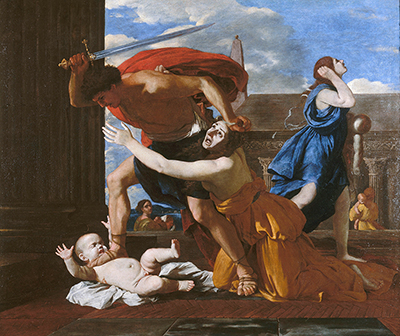Nicolas Poussin completed two different versions of The Massacre of the Innocents over 4 years.
Poussin tended to modify a concept when the need arose. This was not the first time he was doing it. Most of his paintings were either inspired by religious occurrences or social developments. Whenever there was a change in approach, he made sure of modifying his paintings to capture the new angle.
The Massacre of the Innocents (Second Version)
The painting was inspired by the killing of Giustiniani children by the Ottoman Empire in 1564. It shows a soldier trampling on an infant with a raised sword. Begging for mercy was a woman, presumably the infant's mother. She is kneeling trying to reach the sword. The soldier's left hand is on the woman's hair, an indication of dragging her along. The surrounding of the painting shows a posh building, perhaps a palace or an aristocratic home. Right at the back of the scuffle, a woman is passing with her hand on her head, a sign of disbelief for the inhuman treatment on the woman and the child.
The original name of the Painting was in French, Le Massacre des Innocents. It measured 58 inches by 67 inches painted in a classism genre which was synonymous with Poussin. It was drawn on canvas and painted using oil. It took a religious angle with impartiality and guilt of association being the underlying theme. The painting first found at the home at the Palazzo Giustiniani in Rome. From 1804, it was acquired by Lucien Bonaparte who later sold it. Since then, it has exchanged ownership until it reached the Duke of Aumale, Henri d’Orleans. He later gave it out to the Conde Museum in Chantilly.
The Classicism Revolution
It was an artistic representation of Western tradition during the 16th and 17th Century. It showed the social and cultural growth of people in Europe. Emphasis was on cultural beliefs, law and traditional literature. Poussin was good in creating a perfect picture of such occurrences. His conviction was in showing and interpreting religious doctrines and their influence on human beings. Poussin helped cultivate this artistic style to many of his students, among them Pier Francesco Mola, Gerard de Lairesse, Sebastien Bourdon and Jacques Stella. His famous painting around this time was the Bacchanale and Ariadne (1624-5), The Triumph of David (1630), Acis and Galatea (1629) and the Cephas and Aurora (1627).




